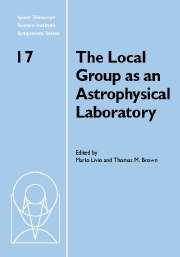 The Local Group as an Astrophysical Laboratory
The Local Group as an Astrophysical Laboratory Published online by Cambridge University Press: 12 May 2010
The galaxies of the Local Group that are currently forming stars can serve as our laboratories for understanding star formation and the evolution of massive stars. In this talk I will summarize what I think we've learned about these topics over the past few decades of research, and briefly mention what I think needs to happen next.
Introduction
My talk today will be restricted to giving a brief introduction to the study of massive stars in the Local Group; I'll begin by discussing why I think the subject is important, and giving you a few of the complications and caveats. I'll spend most of my time then talking about what I think we've learned, first about star formation (stories of star formation, the initial mass function, and the upper mass cut-off), and second about the evolution of massive stars (including Luminous Blue Variables, Wolf-Rayet stars, and red supergiants). Finally I'll conclude with a brief discussion of what I think we need to do next. This talk is based in large part on an Annual Reviews of Astronomy & Astrophysics paper that I have coming out in October (Massey 2003), and the reader is referred there for a more in-depth analysis. I have used this opportunity to update some of the figures and thoughts from that, so hopefully the two will be somewhat complementary.
To save this book to your Kindle, first ensure [email protected] is added to your Approved Personal Document E-mail List under your Personal Document Settings on the Manage Your Content and Devices page of your Amazon account. Then enter the ‘name’ part of your Kindle email address below. Find out more about saving to your Kindle.
Note you can select to save to either the @free.kindle.com or @kindle.com variations. ‘@free.kindle.com’ emails are free but can only be saved to your device when it is connected to wi-fi. ‘@kindle.com’ emails can be delivered even when you are not connected to wi-fi, but note that service fees apply.
Find out more about the Kindle Personal Document Service.
To save content items to your account, please confirm that you agree to abide by our usage policies. If this is the first time you use this feature, you will be asked to authorise Cambridge Core to connect with your account. Find out more about saving content to Dropbox.
To save content items to your account, please confirm that you agree to abide by our usage policies. If this is the first time you use this feature, you will be asked to authorise Cambridge Core to connect with your account. Find out more about saving content to Google Drive.